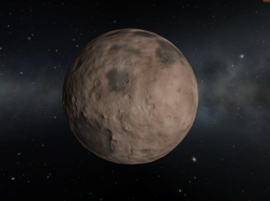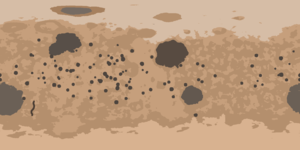Moho/th
| Moho | ||
| Moho as seen from orbit. | ||
| Planet of Kerbol | ||
| Orbital Characteristics | ||
| Semi-major axis | 5 263 138 304 m [Note 1] | |
| Apoapsis | 6 315 765 981 m [Note 1] | |
| Periapsis | 4 210 510 628 m [Note 1] | |
| Orbital eccentricity | 0.2 | |
| Orbital inclination | 7 ° | |
| Argument of periapsis | 15 ° | |
| Longitude of the ascending node | 70 ° | |
| Mean anomaly | 3.14 rad (at 0s UT) | |
| Sidereal orbital period | 2 215 754 s | |
| 102 d 3 h 29 m 14.2 s | ||
| Synodic orbital period | 2 918 346.4 s | |
| Orbital velocity | 12 186 - 18 279 m/s | |
| Physical Characteristics | ||
| Equatorial radius | 250 000 m | |
| Equatorial circumference | 1 570 796 m | |
| Surface area | 7.8539816×1011 m2 | |
| Mass | 2.5263314×1021 kg | |
| Standard gravitational parameter | 1.6860938×1011 m3/s2 | |
| Density | 38 599.500 kg/m3 | |
| Surface gravity | 2.70 m/s2 (0.275 g) | |
| Escape velocity | 1 161.41 m/s | |
| Sidereal rotation period | 1 210 000.0 s | |
| 56 d 0 h 6 m 40 s | ||
| Solar day | 2 665 723.4 s | |
| 123 d 2 h 28 m 43.4 s | ||
| Sidereal rotational velocity | 1.2982 m/s | |
| Synchronous orbit | Outside sphere of influence | |
| Sphere of influence | 9 646 663.0 m [Note 1] | |
| Atmospheric Characteristics | ||
| Atmosphere present | No | |
| Scientific multiplier | ||
| Surface | 10 | |
| Splashed | N/A | |
| Near space | 8 | |
| Outer space | 7 | |
| Recovery | 7 | |
|
| ||
Moho เป็นดาวเคราะห์ขนาดเล็กที่สุดเป็นลำดับสาม และอยู่ใกล้ Kerbol มากที่สุด มีคาบการโคจรที่สั้นที่สุดคือ 102 วัน และเป็น celestial body/th ที่เร็วที่สุดใน Kerbal Space Program/th ด้วยความเร็ว 12 ถึง 18 กิโลเมตรต่อวินาที ดาวเคราะห์ดวงนี้เปรียบเสมือนดาวพุธในชีวิตจริง ซึ่ง Moho ไม่มีชั้นบรรยากาศและดาวบริวารเลย ดาวดวงนี้ได้ชื่อมาจากความไม่ต่อเนื่องของโมโฮโลวิคซิค(ภาษาอังกฤษ) ซึ่งคือรอยต่อระหว่างชั้นเปลือกโลก (crust) กับชั้นเนื้อโลก (mantle) ของโลก
Moho's inclined, low, and eccentric orbit and lack of atmosphere or moons (for aerobraking and gravity assists, respectively) make encountering the planet relatively difficult. Without an atmosphere to retain or block heat, Moho's daytime surface temperatures can exceed 300 °C, making radiators an absolute necessity if any part (such as drills or engines) must be cool to operate both safely and effectively. Moho rotates very slowly, its solar day being over 100 times longer than Kerbin's, which means that reconnaissance satellites will likely wait a long time between targets, but it also means that there may be several opportunities to perform individual measurements across multiple orbits. Although Moho's close proximity to the sun increases solar panel output to 10.4x that of Kerbin's at periapsis, excessive heat can cause cooling issues for mining operations and the extremely long nights will necessitate bringing an alternative power source (RTGs or fuel cells) for extended surface operations.
There is a tutorial for traveling to Moho.
Contents
คำอธิบายในเกม
| “ | Moho figures in Kerbal mythology as a fiery place with oceans of flowing lava. In reality however, it’s much less interesting.
|
” |
ภูมิประเทศ
Moho's surface ranges from light brown highlands to dark brown basaltic basins and a large depression called the Northern Sinkhole near the North pole (not to be confused with the Mohole)-these features, together with surface reports, strongly evidence the presence of past volcanism. Its highest point is in its northern hemisphere at an altitude of 6817 m. Moho's heavily eroded surface and lack of ground scatter despite there being no atmosphere suggest active space weathering processes.
Moho has a very deep well at its geographic north pole, called the Mohole. The Mohole is about 4.6 kilometers deep and 1.7 kilometers across, with a descending angle of 80 degrees. [1] The hole is a glitch in the procedural generation of terrain; many other bodies with land at the north pole have similar bugs.[2] Despite the appearance of another hole at the geographic south pole in Map View, one does not exist.
The Mohole can destroy craft and kill Kerbals that fall into it.
ไบโอม
Moho has 12 biomes. It is one of three bodies (the other being Kerbin and Ike) that have their own North and South Pole biomes. It is dotted with Minor Craters and features four distinct Lowland Biomes. The Mohole is registered as part of the South pole despite being at the North pole.
รายชื่อไบโอม
|
Orbital Statistics
Mohosynchronous and semi-synchronous orbits are impossible — they would require altitudes of 18 182.08 km and 11 361.48 km respectively, both of which are beyond Moho's sphere of influence.
Reference Frames
| Time warp | Minimum Altitude |
|---|---|
| 1× | Any |
| 5× | 10 000 m |
| 10× | 10 000 m |
| 50× | 30 000 m |
| 100× | 50 000 m |
| 1 000× | 100 000 m |
| 10 000× | 200 000 m |
| 100 000× | 300 000 m |
เทียบกับระบบสุริยะ
Moho is the apparent Kerbol System analog of the planet Mercury. Both share a similar cratered landscape, like most bodies with little to no atmosphere. Due to the lack of an atmosphere to retain heat, Moho and Mercury are freezing on the night side and, relative to Earth, extremely hot on the day side. Both planets are also the closest to their respective stars, share a similar orbital eccentricity and lack natural satellites.
However, Moho has a brown surface, while Mercury has a dark grey surface. In addition, Mercury has a tenuous atmosphere of about 10⁻¹³ kPa while Moho has no atmosphere; although, a pressure of 10−13 kPa (≃ 10-15 atm) would be rendered "unmeasurable" by the PresMat Barometer and register in KSP as a vacuum. However, Moho did have a super-heated atmosphere up until 0.18.
ระเบียงภาพ
Hanny Kerman wedged in the Northern Mohole sideways. Lots of orientation jittering was observed.
ความเปลี่ยนแปลง
- เพิ่มไบโอม
- New, procedurally generated, textures added, with higher detail craters.
- Entirely changed more cratered surface.
- เปลี่ยนสีจากสีแดงเป็นสีน้ำตาล
- No more superheated atmosphere.
- No longer tidally locked.
- ลดมวล
- ปล่อยออกมาครั้งแรก








